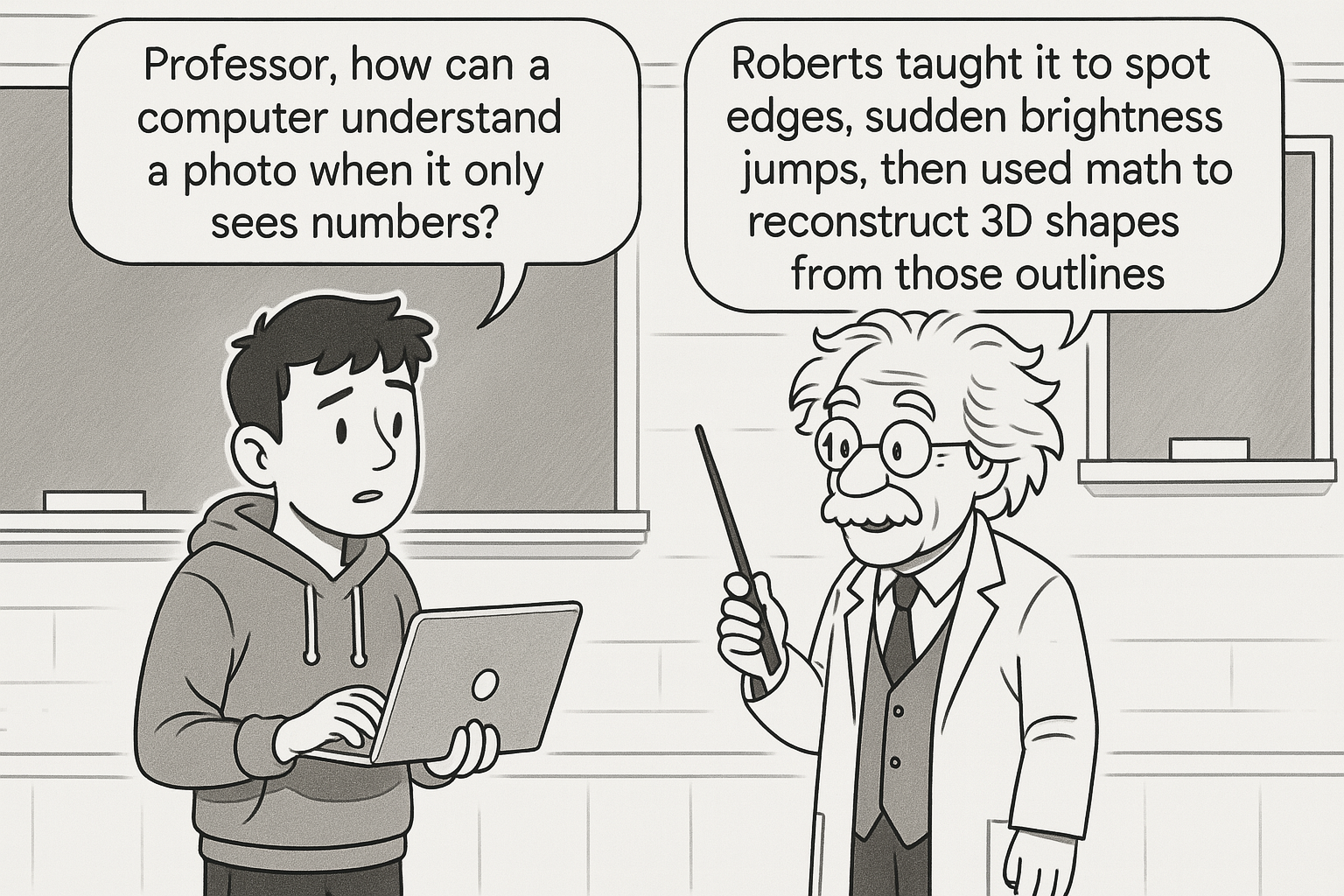Introduction
Lawrence Roberts' 1963 PhD thesis "Machine Perception of Three-Dimensional Solids" at MIT established computer vision as a scientific discipline, introducing the first systematic approach to machine perception of 3D objects from 2D images. Often called the father of computer vision, Roberts created foundational algorithms and mathematical frameworks that remain influential in today's AI-powered visual recognition systems.
"Mathematical frameworks can teach machines to see by transforming visual perception into systematic geometric understanding."
Core Ideas
Roberts tackled a fundamental challenge: how can machines understand three-dimensional objects from flat photographs? His work assumed that photographs are perspective projections of solid objects that can be constructed from transformations of known three-dimensional models, with objects supported by other visible objects or a ground plane.
The core innovation lay in Roberts' systematic approach to depth perception. He discussed extracting 3D information about solid objects from 2D photographs of line drawings, mentioning camera transformations, perspective effects, and "the rules and assumptions of depth perception" - concepts that form the backbone of modern computer vision.
Roberts developed a computer program that could process a photograph into a line drawing, transform the line drawing into a three-dimensional representation, and finally display the three-dimensional structure with all hidden lines removed from any point of view. This was revolutionary for 1963, when computers had severely limited processing power.
His mathematical framework introduced two critical components that became industry standards. Roberts' approach became classical through his homogeneous coordinate system and cross operator for edge detection. The homogeneous coordinate system allowed complex 3D transformations to be expressed as simple matrix operations, dramatically simplifying geometric calculations that previously required complex trigonometric functions.
The Roberts cross operator, proposed in 1963, was one of the first edge detectors and used a differential approach to approximate the gradient of an image through discrete differentiation by computing the sum of squares of differences between diagonally adjacent pixels.
Breaking Down the Key Concepts
Think of Roberts' edge detection like finding the boundaries of objects in a photograph by looking at how quickly brightness changes between neighbouring pixels. Instead of examining every pixel individually, Roberts created a mathematical "template" that could be applied across the entire image to highlight areas where brightness changes dramatically - these changes typically indicate object edges.
His homogeneous coordinate system solved a practical engineering problem. Traditional coordinate systems made it complicated to perform rotations, translations, and scaling operations on 3D objects. Roberts' system added an extra dimension to coordinates, allowing these complex operations to be performed using simple matrix multiplication - much like how modern graphics processing units (GPUs) handle 3D transformations today.
According to Roberts, an edge detector should have specific properties: produced edges should be well-defined, background should contribute minimal noise, and edge intensity should correspond closely to human perception. This human-centred approach to algorithm design was groundbreaking and remains relevant in modern AI development.
The 3D reconstruction process worked by analysing line drawings rather than complex photographic images. Roberts used computer programs to extract 3D structures of polyhedra such as cubes, wedges, and prisms from digital images. This simplified approach made the computational problem manageable for 1960s hardware while establishing principles that scaled to modern systems.
Roberts recognised that machine vision required understanding the relationship between 2D projections and 3D reality. His algorithms essentially reverse-engineered this process, taking flat images and inferring the three-dimensional structure that could have created those projections.

Results and Significance
Roberts' work achieved several groundbreaking results. His 1963 thesis contained "the first algorithm to eliminate hidden or obscured surfaces from a perspective projection", solving a fundamental problem in 3D graphics that affects everything from CAD software to video games today.
The Roberts operator became computationally efficient due to its use of 2x2 convolution kernels, making it suitable for real-time applications. This efficiency was crucial for early computer vision systems with limited processing power and remains valuable in embedded systems and mobile applications where computational resources are constrained.
The Roberts operator was used in early computer vision systems for edge detection in simple images and is often applied in scenarios where computational resources are limited. Modern OpenCV implementations still include Roberts' edge detection algorithms, and the homogeneous coordinate systems he pioneered are fundamental to every 3D graphics framework.
Roberts established computer vision as a quantitative, engineering discipline rather than purely theoretical research. His work demonstrated that machines could systematically extract meaningful information from visual data using mathematical principles, laying groundwork for everything from industrial quality control systems to autonomous vehicle navigation.
The mathematical frameworks Roberts introduced became building blocks for subsequent innovations. His edge detection principles evolved into more sophisticated algorithms like the Sobel and Canny edge detectors. His 3D reconstruction techniques influenced stereo vision systems, photogrammetry, and modern structure-from-motion algorithms used in applications like Google Street View and augmented reality.
Roberts' focus on line drawings wasn't a limitation but a strategic choice. Lawrence Roberts' thesis was about analysing line drawings rather than images taken of the real world, and work in line drawings continued for a long time. This approach allowed him to solve fundamental geometric problems without getting overwhelmed by the complexity of natural images, establishing principles that later researchers could extend to more complex visual data.
Original paper can be found here - https://dspace.mit.edu/handle/1721.1/11589